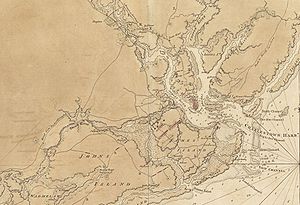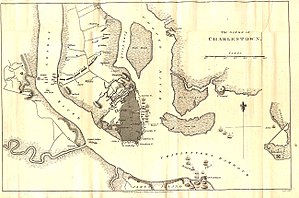Siege of Charleston
The British, following the collapse of their northern strategy in late 1777 and their withdrawal from Philadelphia in 1778, shifted their focus to the North American Southern Colonies.
After approximately six weeks of siege, Major General Benjamin Lincoln, commanding the Charleston garrison, surrendered his forces to the British.
The British were persuaded that there was a strong Loyalist sentiment in the South, where major planters and merchants had a variety of economic and familial ties with Great Britain.
After repulsing an assault on Savannah by a combined Franco-American force in October 1779, the British planned to capture Charleston, South Carolina, intending to use the city as a base for further operations in the southern colonies.
[2] Clinton evacuated Newport, Rhode Island in October 1779, and left the substantial garrison of New York City under the command of Wilhelm von Knyphausen.
In December, the day after Christmas 1779, Clinton and his second-in-command, Charles Cornwallis, sailed southward with 8,500 troops and 5,000 sailors on 90 troopships and 14 warships.
Among those former slaves, known as Black Loyalists, evacuated by the British after the war was John Kizell, who had been captured as a child from the area of Sierra Leone and transported to South Carolina.
[citation needed] Cutting the city off from relief, Clinton began a siege on 1 April, 800 yards from the American fortifications located at today's Marion Square.
Then Arbuthnot, on 8 April, brought his 14 vessels safely into the harbor, past the roaring guns of Fort Moultrie, the same day Woodford arrived with 750 Virginia Continentals.
[2]: 46, 52–53, 55–57 In order to consolidate British control of the immediate area, Clinton dispatched Banastre Tarleton and Patrick Ferguson to capture Monck's Corner on 14 April.
On 6 May, Tarleton won another engagement in the Battle of Lenud's Ferry, while the British siege works had advanced far enough towards the Charleston fortifications to drain the canal in front.
On the same day, the British fired heated shot into the city, burning several homes, and Lincoln felt forced to call for a parlay to negotiate terms for surrender.
"[9] On June 5, Clinton sailed back to New York City, believing his presence necessary to defend against a potential Franco-American attack, leaving command of the southern theater to Lord Cornwallis, with orders to reduce opposition in North Carolina.



